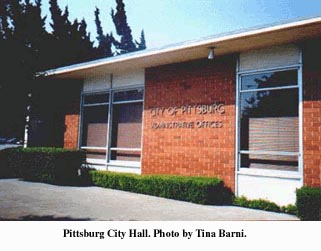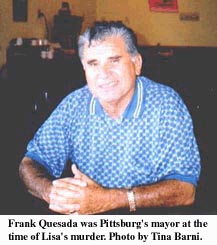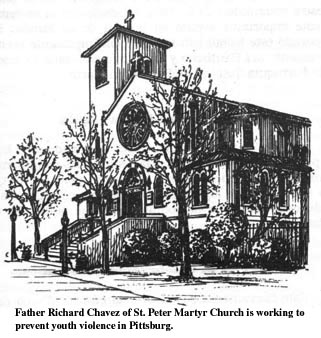Norrell Tragedy Unites Pittsburg Community
Within hours of Lisa's disappearance, community members came together to support each other.
-

Late on a November night last year, several days after she first reported to police that her 15-year-old daughter was missing, Minnie Norrell awoke from a fitful sleep and went to look outside her bedroom window.
There in her front yard, amid the many candles that well wishers carefully had placed and lit in her front walk, she saw a stranger.
She watched quietly as the man moved some of the shining candles aside to make room on the brick walls that line her front path for the one he had brought. He then lit the candle on the walk, which had become a symbol of hope for Norrell and her community, and disappeared into the darkness as silently as he had arrived.
“Pittsburg people are special,” said Norrell, nearly a year later, recalling those agonizing nights and the outpouring of public sympathy and support she felt. “I can’t tell you how many thousands of people were in this house. And I’m talking thousands.”
The tragedy of Lisa Diane Norrell’s disappearance and the news of her murder eight days later brought the community of Pittsburg together in fear and mourning like few other events in recent times, and has helped spark an effort by city officials and religious leaders to address problems of violence and youth alienation.
Lisa’s murder “heightened awareness of people and their surroundings,” said Mayor Federal Glover, 43, a lifetime resident of Pittsburg. “Emotionally it draws the community together. We all learned from the tragedy."
“She was a good person, who happened to find herself in the wrong place at the wrong time,” Glover went on. “Emotionally it makes you want to do more outreach.”
To that end, the
city has held conferences on youth issues and set aside funding for a new teen center and skating park over the past year since Lisa’s killing, which remains unsolved. The city also holds open forums during city council meetings to promote dialogue between the teenagers and adults.
But one of the biggest changes since Lisa’s murder has been in the way Pittsburg officials discuss the problems of the city. According to Pittsburg’s Assistant City Manager, Glenn J. Valenzuela, 50, the city’s leaders were never so involved with young people as they are now.
“Involvement with the youth before Lisa’s death was a priority, but it was not at the front burner,” said Valenzuela. “Now, wherever you go in this city and hear elected officials speak, one of the first words that come out of their mouths is in support of young people. That is real rare in any city.”
Taking Comfort in Family

Pittsburg, a close-knit industrial town of 54,117, is located 40 miles east of San Francisco across the San Francisco Bay. Its hard-working residents are a diverse mix -- 47.2 percent Caucasian, 23.7 percent Hispanic, 17.1 percent African-American, and 11.2 percent Asian, according to the 1990 census. Many of its residents have lived all their lives in a town where Dow Chemical is one of the major employers along with a steel company called USS-POSCO.
They take comfort in their families, do the best they can to get by, and take pride in the city’s multi-ethnic character, which sharply contrasts with other, largely white, suburban towns in otherwise affluent Contra Costa County.
Indeed, at least one Pittsburg official, school board trustee Jim MacDonald, charges that local industries pollute the air and water more freely in Pittsburg than in other Bay Area communities precisely because of the city's working-class and ethnic makeup.
Earlier this month MacDonald proposed that the city demand that the Federal government declare Pittsburg "an environmental justice community." Such status, part of an environmental protection agency program begun five years ago to reduce the effects of pollution and toxic waste in poor and minority areas, would allow the government to oversee the industries and provide funding for education programs.
At first glance, Pittsburg, nestled next to the Sacramento and San Joaquin rivers, has a small-town feel, a safe haven from the problems of the major metropolis. But looks can be deceiving, for like many suburban towns across America Pittsburg is not immune from urban dangers: drugs, prostitution, youth gangs and violence among them. Lisa’s murder was one of at least six last year.
For some time, Pittsburg police have been at a loss about how to eliminate prostitution and the drug houses that became common sights on Ninth and Tenth streets. Gang warfare even began to claim lives.
One such death touched Father Ricardo Chavez enough to prompt him to do something about it. When a teenager named Douglas Askern was killed in a drive-by shooting only a few weeks before Lisa’s death, the town, numbed by the constant violence, did nothing.
“What got to me was that there was no reaction,” said Father Chavez, the priest at a local Catholic church who grew up in Pittsburg. “Nobody put a marker out there, nobody put up a flower or a cross. This was now the umpteenth death and I began to sense that everyone was like I was--you just expect it.”
Lisa Norrell’s murder soon followed, along with the deaths of several prostitutes from the area and brought hordes of Bay Area media attention to Pittsburg (See
ETHICS). Finally, people were paying attention.
“The town just kind of adopted her, kind of like a strange phenomenon,” said Christine Rohde, one of Lisa’s teachers at Pittsburg High. “It was just this cute little girl who wouldn’t hurt a fly and all of a sudden she’s just gone. And violently and horribly.”
"A Wake-up Call to Residents"

In the aftermath of the killings, Father Chavez launched Families Against Violence, a group dedicated to teaching parents how to talk to their kids about violence. The city formed a task force in hopes of combating the problem and after school programs were instituted along with midnight basketball to help keep kids out of trouble.
Mark C. Leonard, 45, a resident of Pittsburg for six years, President of The Rotary Club and a member of the Board of Directors for the
Chamber of Commerce and Boys and Girls Club, said that Pittsburg is no worse than any other city when it comes to crime. Still, he said Lisa’s killing has been a "wake-up call" for residents and police alike to do a more effective job at maintaining security.
“Personally, I don’t want my kids out after dark,” said Kathy C. Meidinger, Executive Assistant at the City Manager’s office and a mother of four. “And I preach to them ‘don’t put yourself in a compromising position,’ which is really what Lisa did. Just don’t walk alone in the dark.”
Lisa disappeared on Nov. 6, 1998 after leaving a rehearsal for a quinceañera party for a Latina girlfriend in an Antioch Hall. She reportedly left in anger and decided to walk home along the largely desolate Antioch-Pittsburg Highway. She never returned home. Her asphyxiated body, her hands knotted in fists, was found face down in the yard of a landscaping firm a week later.
It was a devastating time that council member Frank R. Quesada, 65, among many others in Pittsburg, will never forget. A retired postal worker, and Pittsburg’s mayor at the time of Lisa’s disappearance and murder, Quesada was an old family friend of Lisa and her family. Lisa’s 17-year-old brother Tony Quesada is Frank’s nephew by adoption.
“It was … heartbreaking,” said Quesada. “I saw her grow up. We would go to family functions and see each other. To me it was pretty personal, I knew her since she was a kid. The whole tragedy made you want to help the community.”
Like many, Quesada can’t make sense of the tragedy. He hopes the
$60,000 reward money recently offered by Governor Gray Davis for information leading to arrest and conviction in the case will produce progress in solving a case that has seen little thus far.
“The funny thing, I don’t know what got her to be walking out there,” said Quesada. “It is not a heavily used road, people only used it for east-west traffic for work. Otherwise there is no traffic and no lights, it is very dark. I wouldn’t walk there and I am 65 years old. I know better.”

A statue of a fisherman adorns the Piazza di Isola delle Femmine on the Marina, representing the Pittsburg of the past, a predominantly Italian fishing community where Sicilians had come to make a better life in the early 1900’s. Originally named New York of the Pacific, the town became Black Diamond in 1905 after the discovery of coal in the hills just south of town. In 1911, residents voted to change the name to Pittsburg, after the Pennsylvania city, to reflect its industrial development. The “h” was dropped to simplify the spelling.
When commercial fishing in the bay and rivers was banned by the state legislature in the late 1950’s, the Italian community deteriorated and people began to move out. By then, an influx of people from all over the world had begun to call Pittsburg home and the population grew significantly. The largely Italian community began to give way to a new Latino population along with African-Americans and Filipinos. The change resulted in the exodus of many whites to neighboring Antioch, which consisted mostly of whites, as it does today.
In Pittsburg, the various races learned quickly to live with each other. “As far as I can remember, we got along well,” said Father Chavez. “It was such a small community that there weren’t really a lot of opportunities for doing wrong.”
Pittsburg saved its animosity for Antioch. For as long as residents can remember, there has been a rivalry between the two small towns that culminates in a raucous annual football game between their high schools each Fall.
“Antioch was our mortal enemy,” said Minnie Norrell, a graduate of Pittsburg High. “The Pittsburg-Antioch football game was the last of the year always. They had a lot of security out there because the funnest thing to do on Saturdays was to go to Antioch and start a fight.”
Remembering Lisa
These days, Minnie Norrell continues to mourn her daughter. The mention of Lisa’s name still brings tears to her eyes. But she is also doing what she can to find ways to better Pittsburg after the tragedy. She has been a vocal leader in seeking ways to bring new legislation so that children up to 16 years old will be considered missing instead of being automatically labeled as runaways.

She is also starting a non-profit organization called Lisa’s Closet to provide new clothes to needy children in the area.
And Norrell said she still takes great comfort in the citizens who have helped her cope, all the people who made a point to come to her and tell her how her daughter had touched their lives. She remembers the memorial for Lisa at the school, which drew over 2,000 students, many of whom were looking for ways to express their fear and grief. Norrell sat in the front row as Lisa’s teacher, Christine Rohde, gave a speech.
“It was very hard to speak looking at them because nobody knows what you’re going through until you look and see the pain in their eyes,” said Rohde. “Kids who didn’t even know Lisa just wanted to go up and hug her. She sat there for like two hours and just let kids come up and hug her.”
The children also remembered Lisa by decorating her locker with posters, cards and flowers. They held a candlelight vigil, walking from the high school to Norrell’s house, all the while singing Lisa’s favorite song, “Dreaming of You” by Selena. They crafted yellow ribbons and tissue paper flowers and gathered in Rohde’s room to weep and remember her.
Adults showered Norrell with gifts, flowers, constant visits, phone calls and the rapidly increasing collection of candles on her front walk, where so many strangers took the time to pay their respects.
Today, nearly a year later, a few candles still line Norrell’s front walk and a poster bearing a picture of Lisa remains in the front yard. Students from the high school stop by every once in a while and friends and neighbors still check in on her.
But for Minnie Norrell, who now lives alone in her modest corner house, things will never be the same.
“There is never going to be any closure. When they catch this guy and they kill him, I don’t have any closure,” she said. “My daughter is gone.”

 Late on a November night last year, several days after she first reported to police that her 15-year-old daughter was missing, Minnie Norrell awoke from a fitful sleep and went to look outside her bedroom window.
Late on a November night last year, several days after she first reported to police that her 15-year-old daughter was missing, Minnie Norrell awoke from a fitful sleep and went to look outside her bedroom window. Pittsburg, a close-knit industrial town of 54,117, is located 40 miles east of San Francisco across the San Francisco Bay. Its hard-working residents are a diverse mix -- 47.2 percent Caucasian, 23.7 percent Hispanic, 17.1 percent African-American, and 11.2 percent Asian, according to the 1990 census. Many of its residents have lived all their lives in a town where Dow Chemical is one of the major employers along with a steel company called USS-POSCO.
Pittsburg, a close-knit industrial town of 54,117, is located 40 miles east of San Francisco across the San Francisco Bay. Its hard-working residents are a diverse mix -- 47.2 percent Caucasian, 23.7 percent Hispanic, 17.1 percent African-American, and 11.2 percent Asian, according to the 1990 census. Many of its residents have lived all their lives in a town where Dow Chemical is one of the major employers along with a steel company called USS-POSCO. In the aftermath of the killings, Father Chavez launched Families Against Violence, a group dedicated to teaching parents how to talk to their kids about violence. The city formed a task force in hopes of combating the problem and after school programs were instituted along with midnight basketball to help keep kids out of trouble.
In the aftermath of the killings, Father Chavez launched Families Against Violence, a group dedicated to teaching parents how to talk to their kids about violence. The city formed a task force in hopes of combating the problem and after school programs were instituted along with midnight basketball to help keep kids out of trouble. A statue of a fisherman adorns the Piazza di Isola delle Femmine on the Marina, representing the Pittsburg of the past, a predominantly Italian fishing community where Sicilians had come to make a better life in the early 1900’s. Originally named New York of the Pacific, the town became Black Diamond in 1905 after the discovery of coal in the hills just south of town. In 1911, residents voted to change the name to Pittsburg, after the Pennsylvania city, to reflect its industrial development. The “h” was dropped to simplify the spelling.
A statue of a fisherman adorns the Piazza di Isola delle Femmine on the Marina, representing the Pittsburg of the past, a predominantly Italian fishing community where Sicilians had come to make a better life in the early 1900’s. Originally named New York of the Pacific, the town became Black Diamond in 1905 after the discovery of coal in the hills just south of town. In 1911, residents voted to change the name to Pittsburg, after the Pennsylvania city, to reflect its industrial development. The “h” was dropped to simplify the spelling. She is also starting a non-profit organization called Lisa’s Closet to provide new clothes to needy children in the area.
She is also starting a non-profit organization called Lisa’s Closet to provide new clothes to needy children in the area.









